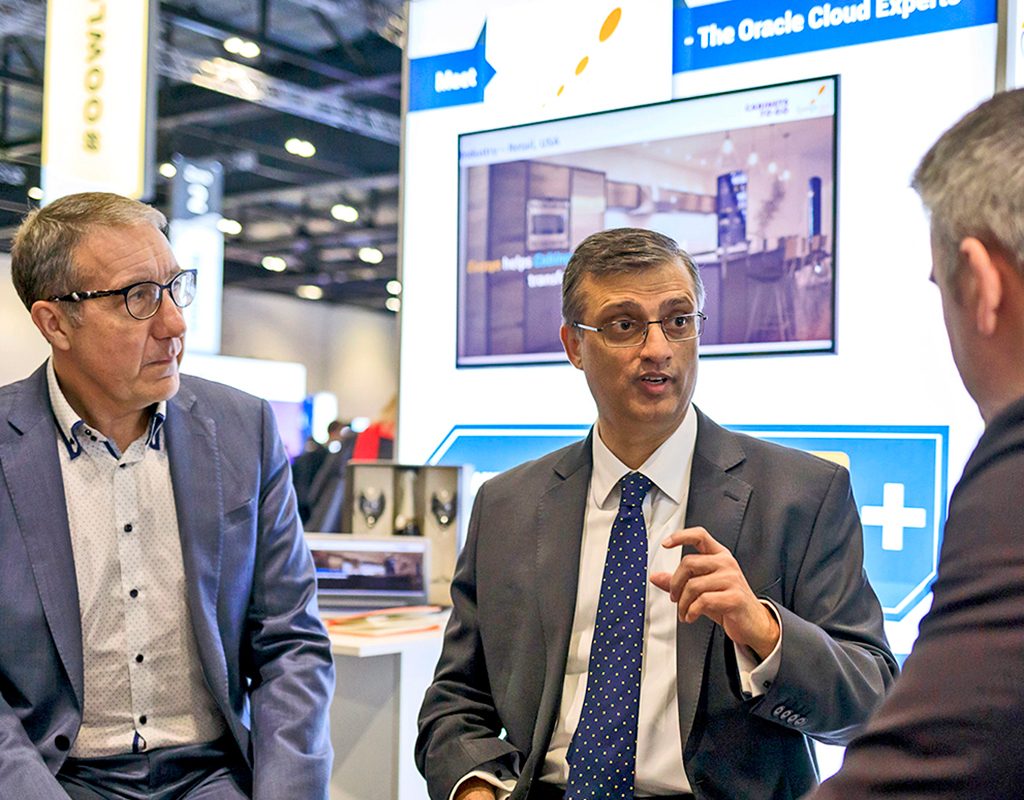As we slowly start to see the easing of restrictions on the UK economy business leaders are faced with a dichotomy; the sudden shift to new ways of working has highlighted the fragilities in many business systems and process – if you hadn’t invested in digital technology before COVID struck it must be an absolute priority now. On the other hand; many businesses are facing significant financial pressure as markets contract and customers become harder to find – surely now is the time to hold on to cash, hunker down and wait for better times?
I can argue this topic both ways. I see the imperative for all businesses to modernise their operating platforms so that they can be agile and respond to the rollercoaster economy. But I can also see the wisdom in protecting cash, reducing spend and rationalising business models. In search of answers, I spoke to three ERP vendors and some of their partners to find out what advice they were giving to their customers and how they proposed to overcome the delicate balance between financial prudence and future proofing business resilience.
It should be obvious that if a company had an ERP project planned it follows that there was a requirement for the project in the first place – or at least it should. It is unlikely that those drivers will have disappeared, perhaps they have even been brought into sharper focus, so the underlying necessity for change remains. However, with many businesses struggling just to keep the lights on there will be a new and bigger set of challenges facing any organisation embarking on an ERP project.
“For projects that were planned there was inevitably a reason why it was on the roadmap. These factors are unlikely to have changed,” said Marie Abery, Dynamics business group director at Microsoft. “Some factors will be more relevant than ever, for example, streamlining operations, improving efficiency and saving costs. In other cases the rollback option will not be very desirable.”

As Abery states, the underlying reasons for planning an ERP project will remain. However, it is important that business leaders do not confuse the COVID-19 pandemic and associated business disruption with the type of disruption that was previously driving decisions to invest in new technology. It’s been said many times recently that COVID-19 was more likely to drive digital transformation than any CxO could. But the reality is that coronavirus is not a disruptor – it is an accelerator and a magnifying glass. What was true before remains so today – we are just likely to get there a little quicker now that everyone has had this very unwelcome shot in the arm.
If we are to conclude that the rationale for most ERP projects has not gone away – and in many cases has been exacerbated by recent events – what is the prognosis for the ERP market in the short and medium term? Despite the apparent need for new technologies to meet the demands of a rapidly changing global environment – is there the stomach for investment in technology right now and can businesses afford to take their eye off their core activities when many are in such a state of flux?
Abery concedes that some projects will stall or get postponed but suggests that doesn’t mean businesses can’t still continue to innovate even if now is not the right time for a full scale ERP transformation.
“Undoubtedly some projects will be put on hold as businesses look to conserve cashflow and focus on business continuity,” said Abery. “For companies that decide it’s not the right time to replace their ERP system this doesn’t stop a level of innovation. Using low-code platforms like Microsoft’s Power Platform, companies can orchestrate processes and build applications that span those systems through hundreds of pre-built connectors and put a modern, mobile and potentially virtual agent face on those systems.”

Owen Dowden, director of business development at Hitachi Consulting, says that while some projects that were yet to start have been pushed back there are signs of a quick recovery as businesses recognise the shortcomings in their incumbent systems and move towards solutions that offer greater agility.
He said: “Many plans and projects were understandably put on hold as the lockdown hit to allow resources to be prioritised towards COVID response or in some cases furloughed, but we are starting to see things move again and we are not seeing any projects scrapped, just delayed. For many, COVID has emphasised the importance of modernisation by exposing the limitations and risks within existing, analogue operating models. It has also highlighted the importance of agility – or how quickly and effectively companies could reforecast, scenario plan or support new reporting needs and how reliant businesses were on small groups of individuals and the consequences of them becoming ill.”
The crisis facing businesses of all types has highlighted weaknesses in the most robust of businesses. Now that the initial storm has subsided business leaders must focus their attention on tackling concealed weaknesses in their technology landscape so they are better prepared for future disruption – however it may come.

Many of those weaknesses will have been felt in the extreme by businesses that remained on legacy platforms as they simply do not afford the same level of agility and flexibility as modern cloud ERP. Phil Burgess, managing director at Inoapps agrees and told me that continuing with legacy applications and infrastructure made even less sense in the post-COVID world.
“It’s a bit like the foundations of your house – you can’t keep building on rotten foundations and expect the house to stay up and the same applies for ERP systems. At some point you’ve really got to address the underlying issues and you are going to have to adjust the core of your business.”
Burgess also noted that whilst he had feared a downturn in their project related work as organisations retrenched and refocussed on the immediate implications of the COVID-19 crisis, the reality had been that far fewer projects had stalled than expected.
“A good example would be Skanska – we’re in the middle of a big implementation with them and they are in construction so you couldn’t be any worse hit. In our conversations with the programme sponsor it was made absolutely clear that the project to modernise their systems and processes was absolutely key to their strategic plans and they wanted us to carry on delivering to the same timetable before COVID struck. It was the same for the University of Edinburgh. They are two really big projects for us which would be substantial if they stopped. But both of them said the same thing so one of the lessons learned for me has been – I think we probably underestimate how important our projects are to the customers.”

Gary Barnes, senior vice president at Evosys, also stated that whilst the general outlook for businesses in the short term is uncertain, the need for modernisation of ageing business systems was more paramount than ever.
He said: “Whilst the post COVID-19 economic market remains fragile and highly volatile, there are strong signs that the extremely challenging times faced by business leaders have further highlighted, and indeed accelerated, the consideration of modern integrated cloud ERP solutions.
“These considerations in my experience are being driven by three key aspects; the constraints of the link between a traditional office and a data centre, the ability to make agile decisions based on reliable information, and the capability to react rapidly to unexpected changes in circumstances. Modern cloud ERP solutions tick all of these boxes by providing a single source of truth that affords businesses connectivity, flexibility, and innovation that is simply not available from legacy solutions. This along with the prospect of a significantly lower TCO and constantly reducing cost of change is driving the consideration of cloud ERP up the corporate agenda, even in the most demanding times.”
What should be at the top of the CxOs agenda?
As if the challenges for business leaders were not great enough before coronavirus – now they have to contend with greater acceleration in disruption, rapidly changing human capital management requirements, increased uncertainty and more pressure to deliver systems that support their people and customers – all at a time when most are struggling to identify where their next customer is coming from.
“In the short term, CxOs need to get businesses moving again and ensure they can operate effectively and safely while ensuring they have a clear plan for managing any future COVID-related restrictions”, said Dowden of Hitachi. “In the medium term, CxOs must plan for uncertainty by building a more agile operating model. No-one knows exactly how COVID will play out for the rest of this year and it will not be the last crisis to deal with. The only thing certain is the need to manage uncertainty by becoming more responsive to change. Building agility into systems and processes is the key competency for success in the new world and we expect this need to be a key driver of investment.”
And Abery from Microsoft agrees suggesting that establishing operational efficiency is key to getting businesses back on their feet.
“CFOs need to operate with speed and flexibility across forecasting, planning, resource allocation and decision making. Digital tools like robotic process automation, analytics and machine learning can help with quicker decision making. There will be a renewed emphasis on operational efficiency, expense management and cost control. For CIOs, they are setting their sights on the ‘new normal’, with a remote workforce being a larger proportion than pre-COVID. CIOs will continue to invest in remote working capabilities including virtual contact centres, remote learning, employee collaboration and meeting technologies whilst securing additional bandwidth and network capacity.
What are the quick wins for ERP customers?
Very few of the vendors sell any net new on-premise solutions so the type of projects most people are considering fall into two brackets; transformation and SaaS, or platform migration and co-existence – which is a half-way house towards transformation.
If we look at the Oracle landscape in isolation, many users are at a crossroads with their systems. The on-premise solution has been around since the 1980s and although Oracle is now investing in EBS (Oracle E-Business Suite), many customers are not seeing any of that benefit because they have been left behind on old versions. The deadline to move to the latest and last version is looming and the timescale can now be measured in weeks and months rather than years – customers will soon be faced with some difficult decisions. But those decisions will likely have a different focus in the wake of the coronavirus crisis. Legacy customers will have felt a particular strain on their ageing systems and some will not have been able to adapt and pivot with the same speed and agility as their competitors. The argument for many businesses staying on legacy apps is that ‘it works for them’ and when the seas are calm that is all they need them to do. But in choppy waters any shortcomings will be exposed and if a change of direction is required in short order, few if any will have been able to react as eruditely as competitors operating with a flexible cloud solution behind them.
As Burgess of Inoapps told me, moving the infrastructure layer to the cloud so that the business is operating on a modern platform is often the best stepping stone that can deliver easy wins in terms of cost saving and business dexterity. “If you’re a big user of EBS and you’re not ready for your big cloud transformation yet, there are cost savings and improvements to agility to be had just in moving your technology platform to the cloud,” he said.
And Dowden from Hitachi agreed, saying: “Moving Oracle EBS onto cloud infrastructure is the quick win in my opinion and can offer improvements in operational costs, system performance and agility.
EBS customers can also explore wider optimisation opportunities, for example introducing robotic process automation (RPA) software to automate high volume and repeatable EBS processes or apply a modern visualisation layer to empower users with improved and more flexible reporting.”
Now could be the time to negotiate a great deal
ERP vendors always put some gloss on their numbers. It keeps the sales teams motivated, reassures existing customers that they are in safe hands and attempts to demonstrate to the markets that everything is ‘hunky dory’. Reporting that you’ve missed a revenue target or your subscription numbers are down is not something that sits particularly well within the boardrooms of the big players. Of course, many execs will know by now that the numbers they predicted last year are unlikely to be met – even if they won’t publicly admit that just yet – and that represents an excellent opportunity for the savvy CFO to negotiate a great deal for some new ERP software.

Bradley Jarrett, managing director UK&I, at bancon agrees and told me that the ambitious targets that vendors set out to the markets and analysts could play into the hands of business leaders who are planning an ERP project soon.
“The impending economic downturn provides the perfect backdrop for businesses to negotiate discounts with vendors. The salesforce will still be encouraged to meet optimistic targets set prior to the coronavirus pandemic and whilst boardroom members may have accepted the fact that these targets are unlikely to be met, it’s doubtful these views will be shared across the business. However, while the economic environment is often the deciding factor as to whether an upgrade takes place or not, it’s actually only one of many just factors to consider when trying to achieve a reduced licensing cost. One key factor includes whether or not you are considering a cloud variation opposed to on-premise. The reason for this is that several vendors, including SAP, have set optimistic targets for their cloud-based solutions. Meeting these targets, irrespective as to whether they are sold at a considerable discount, brings benefit in itself to the vendors. So, if a cloud-based solution is a viable option for your business this could further increase your negotiation power.”
Whether you are an Oracle customer moving your EBS applications to the cloud or an SAP customer migrating to Suite on HANA, often the shortest route to tangible value from your investment in enterprise technology is in the infrastructure layer.
Whilst Burgess’ previous comments about addressing the core issues of your system are valid it may not be the appropriate time to consider a rip and replace of your back office functions. Innovating around the edges, rationalising costs and above all else, migrating to a platform that allows you to be agile should be the first priority for any business seeking ways to thrive in the rollercoaster economy.
One thing is for sure, businesses won’t be able to save their way out of trouble. Whilst reducing costs where possible is a sensible strategy, failing to invest in technology which will offer longer term cost reductions, along with the agility required in the short term, would be a tragic mistake. There will be winners and losers in every vertical sector and the winners are likely to share some common DNA – near the very top of the list of attributes for enterprises wishing to ride out the storm and come out the other side stronger will be agility – and modern cloud erp infrastructure offers that in spades.
Summing up Abery said: “Leaders know that now is the time to evolve their product or service offerings to respond to evolving customer needs. The worst thing to do in a likely recessionary period is to stop innovating. Relying on reducing overheads and cost is one way to save but having this as the only strategy may mean missed opportunities to deliver long-term growth.”
How will COVID-19 impact the world’s biggest erp vendor?
SAP is the world’s premier ERP vendor with more than 440,000 customers worldwide. Virtually every Forbes 2000 enterprise has some sort of SAP tentacle in their business and the vendor’s favourite boast is that 77 percent of all transactions across the globe touch an SAP system. It’s a $30bn juggernaut that sets the standard for enterprise technology but it is wrestling with a problem that doesn’t seem to have an obvious fix.
All vendors develop new versions of their software – that’s their business model and moving existing customers to the next best thing is how they all operate. But SAP’s move to S/4 has not been without issue and the recent departure of two CEOs coupled with a massive acquisition which is yet to gain serious traction has caused some nervousness amongst partners and customers. Analysts and integrators that rely on SAP’s product success for their lifeblood had predicted big things for S/4 in the latter half of 2020 – but coronavirus had other ideas and now many are left wondering if and when the surge towards S/4HANA will begin.
Could this have come at a worse time for SAP?
The anticipated tsunami of enterprises rushing to upgrade to S/4 hasn’t really materialised and the world’s most dominant ERP vendor has been trying to balance supporting their install base with some shock and awe tactics to get them to buy the latest product. Whilst it claims that more than 300 customers signed up for S/4 in Q1 of this year there is little evidence that many of them have started their projects, let alone are actually live. Two notable highlights for SAP were the announcements that the first phase of the De Nora Group (S/4HANA on-prem) and Komax(S/4HANAH cloud) projects managed to go live right in the middle of the global lockdown – no small feat considering the projects were delivered with a completely remote model – but it’s hard to imagine too many other projects would have been started or finished under the same circumstances.
About six months ago I hosted a roundtable with all of the major SAP partners and they expected a significant uptick in the trajectory for new projects – right about now. Whether it would have materialised without the intervention of COVID-19 is debatable but what is certain is the presence of a global economic shutdown has done little to entice enterprises to take the plunge into a long and expensive SAP project.

I asked Jan Gilg, president of S/4HANA at SAP, whether coronavirus had come at the worst time possible for S/4 and his response was unsurprisingly positive but did lack the kind of detail and substance that would lead me to believe that all but a few enterprises are still very cautious about diving into S/4.
He said: “There is never a good time for a pandemic and COVID-19 is a global crisis that is impacting both businesses and private lives. It will have a lasting effect on our societies and I’m convinced it will accelerate the trend towards digital transformation and cloud computing. Companies will have to redefine and focus on their core competencies, dive deeper into customer relationships, develop new business models, adapt their supply chains, streamline their operations, and manage their finances. Those that have an intelligent ERP backbone such as SAP S/4HANA to support their business functions will be able to do this quickly and will emerge stronger.”
Asked whether the global lockdown would have any impact on the planned trajectory for the S/4 roadmap Gilg was keen to point out that COVID-19 has not affected the vendor’s ability to support its customers and highlighted the latest release which was delivered remotely and contained the much anticipated integration for SuccessFactors, along with updates to finance and supply chain functionality.
He said: “As a knowledge company, SAP employees are able to work remotely, and still develop software, support our customers, and operate mission-critical systems. From cloud infrastructure to customer support and learning, contingency plans have been put in place very quickly and activities switched to virtual. We were able in turn to empower our customers like De Nora to go live with SAP S/4HANA and Komax to go live with SAP S/4HANA cloud in a remote way. The latest release has functions for supply chain, finance and SuccessFactors integration which addresses the most urgent needs of our customers dealing with the COVID-19 crisis. Productivity of our development teams has remained consistent. We recently delivered the May 2005 release of SAP S/4HANA Cloud remotely and we also do not see any COVID-19 related impact for delivering the next release.”

So how does the narrative from inside SAP compare to the thoughts from within the partner eco-system that SAP is so heavily reliant on it to deliver its products? I spoke to Gerren Mayne, SAP director for digital technologies at Fujitsu to get his views. Mayne has lived and breathed SAP for three decades and by his own admission – he loves the product. But, like many other SAPers that I speak to there is a growing sense of disconnect between the SAP narrative and the reality in the market.
He said: “If you cut me in half I’d be SAP through and through. It’s been very kind to me and my career and I genuinely love the product. But I fear at the moment that this has come at absolutely the wrong time for them. I think most people that look at SAP feel it’s a little bit confused and the messaging is not quite right. Most of the marketing in the early days talked about speed but they really should have focussed on the business case.”
Building a business case for S/4 is a recurring problem that I hear from both end-users and the partner eco-system. The original idea for S/4 was a greenfield approach which looked horrible on paper and the time to value, if that was even a consideration, was lengthy in the extreme. More recently, partners have developed innovative solutions to expedite the migration path to S/4 and some projects have been conceived, designed and implemented in as little as nine months. But they are the exception rather than the rule and big businesses, and their weary execs know full well that a global greenfield implementation of S/4 is an undertaking not for the faint-hearted.
“The problem is you can’t decouple the specific business case for S/4 with what’s going on more widely in the organisation,” said Mayne. “Most of the S4 programmes we’ve worked on have not been driven by a business case for S/4 – there’s been something else going on in the business. We’re seeing a lot of projects being wrapped up in bigger business transformation programmes rather than being a pure S/4 programme. If you can sit off the back of a wider business transformation you can start to see the value – the only thing is if that’s happening next year, they’ll move to S/4 next year. If that’s happening in four years’ time, they’ll do it in four years’ time.”
SAP recently announced that it was extending the deadline for ECC6 and whilst the deadline imposed by SAP was never going to be a driver to buy S/4, taking the pressure off has allowed customers the time and space to consider the options more carefully.
“We weren’t seeing a rush in the UK for organisations to upgrade to S/4 before the ECC deadline was extended and when it was we instantly saw the fizz come out of it. Now the pressure is off we are seeing a lot more clients talking to us about taking their ECC6 environments and putting it onto the new platform so they can use the data tools within those platforms to give the end to end visibility that perhaps they would have got with S/4. It’s a move towards S/4 but in an incremental way and that’s the way a lot of organisations are looking at this now.”
Undoubtedly the timing of the COVID-19 shut down has impinged the trajectory for S/4 – but it has affected the other vendors too. The reality is that I can’t see too many big ticket ERP projects kicking off in the second half of 2020 as businesses will be far more cautious about adding in new layers of disruption in already difficult circumstances. That said, as Gilg rightly states, enterprises will need the agility and intelligence that S/4 offers to come out the other side stronger and more able to deal with the ups and downs of the post-COVID era. But the anticipated surge is more likely to be a gradual trickle, and as Mayne concluded, “I think we’re all going to have to be a little bit patient with S/4 because it’s going to be driven by business timelines, not by SAP sales targets.”






